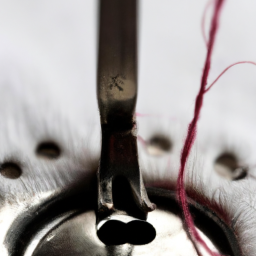The invention of the sewing machine in the 19th century revolutionized the textile industry and had a profound impact on the history of clothing production and fashion. The sewing machine allowed for quicker and more efficient production of garments, leading to changes in the way clothes were manufactured and the accessibility of fashionable clothing for people from different walks of life.

Industrial Revolution and Textile Factories
One of the first significant uses of the sewing machine was in textile factories during the Industrial Revolution. The machine replaced much of the manual labor previously required for stitching garments, increasing production rates and reducing costs. This mass production of clothing contributed to the rise of ready-to-wear fashion and allowed for the availability of affordable clothing for the general public.
Home Sewing and Domestic Use
As the sewing machine technology improved and became more affordable, it transitioned into households, empowering individuals to create their own clothing at home. This was a significant shift as it gave more control to people over their fashion choices and enabled them to express their creativity through sewing. Sewing machines also played a role in making repairs and alterations to garments, extending the lifespan of clothing items.
Global Impact
The sewing machine has had a global impact, reaching far beyond the industrial textile centers of Europe and the United States. As the technology spread to other regions, it became a valuable tool for local artisans and small-scale clothing production. In developing countries, sewing machines have been instrumental in establishing cottage industries, enabling individuals to earn a livelihood by creating clothing and textiles for their communities.
The usage of sewing machines continues to evolve in the modern era. While automated machines dominate large-scale clothing production, there is a resurgence of interest in traditional sewing techniques and craftsmanship. Sewing machines are now found in schools, community centers, and homes around the world, nurturing creativity and preserving the art of sewing.
Conclusion
The sewing machine has left an indelible mark on the history of clothing production and the fashion industry. From its early days in textile factories during the Industrial Revolution to its widespread domestic use, the sewing machine has transformed the way garments are created, allowing for mass production, individual creativity, and increased accessibility. Its impact has been felt globally, empowering individuals and communities through textile production and craftsmanship.





Interesting topic! #SewingMachines
#SewingMachines have been an integral part of many cultures and a tool for craftsmen and women of all ages, proving to be an invaluable addition to the creation of various clothing and home furnishing items. From the Chinese practice of using cross-stitching in the 5th century BCE to the invention of the mechanical sewing machine in the 19th century, the history of sewing machines has been vastly varied and timeless. With endless possibilities for design, the sewing machine has served a defining role in human culture for centuries.